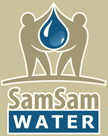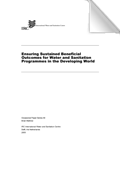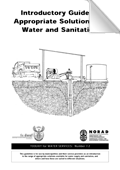
Filter by category
Or search
Loading search form...
Explanation
SamSamWater makes information on water and sanitation easy to find and accessible for all. This page contains a database with practical information, data and (GIS)maps.
We believe information should be shared to make water and sanitation projects more successful. The information in the database is gathered from numerous sources, such as research institutes, companies, NGOs and government organisations.
Do you have information we can integrate into this database, or if you have comments or questions, please contact us!
8 items found within the categories:
Sanitation
Clear search filter.
Brian Mathew, IRC (2005)
WHO, WHO (2006)
Richard Holden, Tania Swanepoel, DWAF (2004)
NWP, NWP (2006)
WaterAid, WaterAid (2007)
Sanitation
Clear search filter.
SSWM Toolbox
The Sustainable Sanitation and Water Management Toolbox is an open-source capacity development tool for the local level, linking water management, sanitation and agriculture.
Focussing on the human influence on the water and nutrient cycle, it presents solutions for a sustainable use, treatment and reuse of water resources.
The Toolbox aims at capacitating people not only with knowledge, but also with application skills. It provides both help in project planning and implementation, focuses on technologies (hardware) and behavioural change approaches (software), and compiles the relevant further readings, links, exercises etc. for each topic. In that way, it is not a reinvention of the wheel, but the long needed overview on the host of approaches and technologies in the water and sanitation sector. The Toolbox contains also a large library, a glossary, a Train-the-Trainer's section topped by downloadable and adjustable PowerPoint presentations on specific topics. It is open source and for free – but quality approved. Today, the Toolbox is used as online resource for both, learning and teaching. This concept is coupled with training courses and workshops based on a worldwide network.
Focussing on the human influence on the water and nutrient cycle, it presents solutions for a sustainable use, treatment and reuse of water resources.
The Toolbox aims at capacitating people not only with knowledge, but also with application skills. It provides both help in project planning and implementation, focuses on technologies (hardware) and behavioural change approaches (software), and compiles the relevant further readings, links, exercises etc. for each topic. In that way, it is not a reinvention of the wheel, but the long needed overview on the host of approaches and technologies in the water and sanitation sector. The Toolbox contains also a large library, a glossary, a Train-the-Trainer's section topped by downloadable and adjustable PowerPoint presentations on specific topics. It is open source and for free – but quality approved. Today, the Toolbox is used as online resource for both, learning and teaching. This concept is coupled with training courses and workshops based on a worldwide network.
Akvopedia from Akvo.org
Wikipedia-like knowledgebase on water and sanitation. Contains many useful smart and affordable technical solutions and effective approaches.
Appropedia
Wikipedia-like knowledgebase on collaborative solutions in sustainability, poverty reduction and international development. Including sections on Water and Health.
Ensuring Sustained Beneficial Outcomes for Water and Sanitation Programmes in the Developing World
Brian Mathew, IRC (2005)
A thesis that gives approaches to achieve sustained beneficial outcomes from WATSAN (WAter and SAnitation projects in development countries). Secondly it gives insight in the up-scaling of these approaches, (source)
Serie:
Occasional Paper Series 40 (all items in this serie)
Categories:
Socio-economic and organisation
Sanitation
Occasional Paper Series 40 (all items in this serie)
Categories:
Socio-economic and organisation
Sanitation
Guidelines for drinking-water quality
WHO, WHO (2006)
The document describes a “Framework for Drinking-water Safety” and discusses the roles and responsibilities of different stakeholders, including the complementary roles of national regulators, suppliers, communities and independent “surveillance” agencies.
Introductory Guide to Appropriate Solutions for Water and Sanitation
Richard Holden, Tania Swanepoel, DWAF (2004)
This guideline is for use by municipalities and their service providers as an introduction to the range of appropriate solutions available for water supply and sanitation, and where and how these are suited to different situations. (source)
Smart Sanitation Solutions
NWP, NWP (2006)
This booklet on sanitation, like its counterpart Smart Water Solutions, gives examples of household and community-based sanitation solutions that have proven effective and affordable. It illustrates a range of innovative sanitation technologies that have already helped thousands of poor families to improve their lives. The technologies described are a source of inspiration. (source)
Technology notes
WaterAid, WaterAid (2007)
These technology notes have been prepared following many general enquiries for technical information having been received by WaterAid over the years.
Their purpose is to give an outline of the technologies used by WaterAid on long-term development projects in Africa and Asia, and to show alternatives which might be appropriate in different circumstances.
It may be possible to determine from the notes the technology which would be appropriate in a particular location.
If it is proposed to proceed with the design and construction of a project using any of the principles set out in these notes, it is strongly recommended that further details be obtained from a specialist or from the reference books which are listed at the end of the relevant section. (source)










